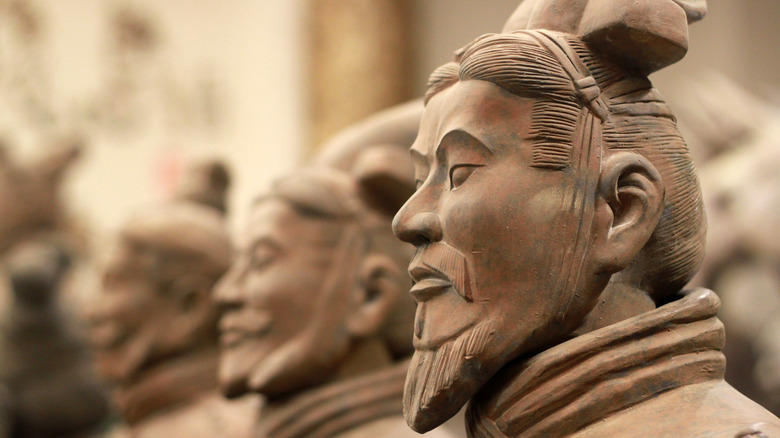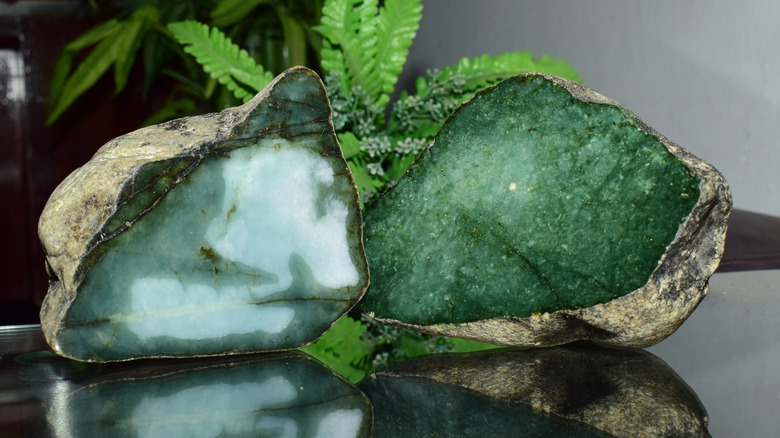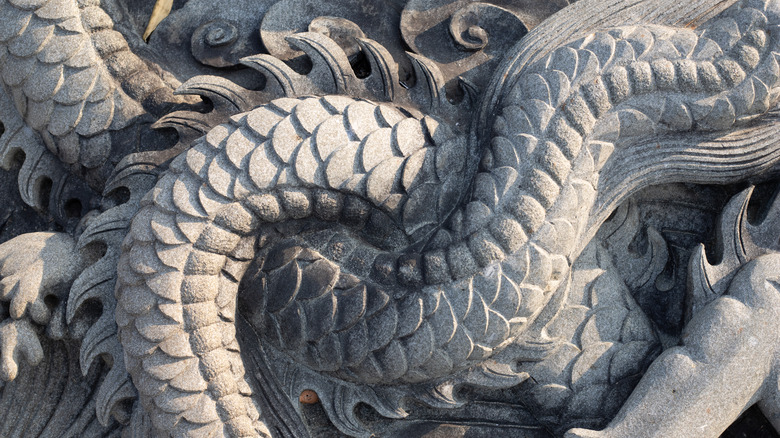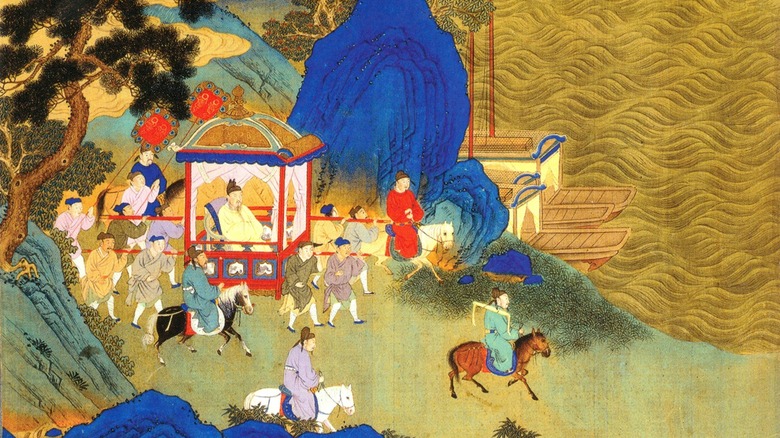The Mystery Of The Heirloom Seal Of The Realm
"Jade is soft, sweet, and shiny to the touch like benevolence. Strong, compact and beautiful like intelligence. Sharp, without being keen, like justice. Bright and shiny, like purity. Its defects are never hidden, like education and sincerity." This description by Chinese philosopher Confucius (551-479 B.C.E.) tells us everything we need to know about the revered, nigh sacred status of not only jade within China but also one of the most symbolically and historically critical artifacts carved from its facets: the Heirloom Seal of the Realm (via Discover Places).
The Heirloom Seal of the Realm was crafted for use by China's first emperor, Qin Shi Huang, following one of ancient China's most famous and mythologized periods, the Warring States period (481-221 B.C.E.). At the end of a three-centuries-long, dogged, nationwide competition for power between seven states — Chu, Han, Qi, Qin, Wei, Yan, and Zhao — Emperor Qin rose to leadership and set China on course for its future cultural prosperity (via World History).
The personal, imperial seal he used for documents— the Heirloom Seal of the Realm — wasn't a mere lifeless dongle of stone absentmindedly plunked into wax during a daily round of bureaucratic document-stamping. The seal has unrivaled symbolic significance and came to embody the emperor's dynastic power and his "right to rule," so to speak, dubbed the "Mandate of Heaven" (per World History). It provided physical, tangible evidence of the legitimacy of his reign. But somehow, somewhere, it simply vanished around 907-960 C.E. (via Ancient Origins).
The warring states draw to a close
To truly understand the importance — and mystery — of the Heirloom Seal of the Realm, we've got to go back to the millennia leading up its creation. Evidence regarding China's ancient history goes back as far as 2070 B.C.E. when the greater region came to be ruled by the Xia family, a dynastic line that persisted until 1600 B.C.E. As Thought Co points out, information from the Xia period is scant, inconsistent, and often resembles mythology. Tales include a yellow dragon and black turtle helping the ideal ruler, Yu the Great, stop a flood. While this could certainly be metaphorical, other advancements attributed to the era seem more credible, such as the development of irrigation, bronze smelting, calendars, and the wheel.
By the time we pass through the Shang dynasty (1600-1050 B.C.E.) into the Zhou dynasty (1046-256 B.C.E.), China experienced a cultural boom, developed writing, but then fractured into various states with their own feudal leaders (via World History). And so, around about 481 B.C.E., a ferocious battle for dominance began in continental China (some historians claim the period started in 403 B.C.E.). This Warring States period saw the development of new military technology like cavalry and iron weapons, and in the end, the victory and rise of China's first emperor, Qin Shi Huang, whose Qin dynasty ruled for a mere fifteen years (221-206 B.C.E.). It was he who ordered the Heirloom Seal of the Realm carved with his imperial symbol.
Jade's mystical beauty
By all accounts, the Heirloom Seal of the Realm was (or is, if it hasn't been destroyed) composed of pure jade, which made it a potent symbol of dynastic power. As China Daily puts it, "If the Mandate of Heaven had a physical form, it would be a 4-inch-square block of the purest jade in the realm." Jade has a long, storied, and deeply significant place in Chinese history, which made it and its nigh-mystical reputation perfect for imperial use.
Even the word for jade, "yu," means "the most precious thing" (via Discover Places). On a purely aesthetic level, jade is obviously pretty. But in ancient China, jade was used for a whole host of purposes beyond mere adornment. Tools, utensils, musical instruments such as flutes and chimes: all of these and more were once made from cut jade (via Thought Co). Jadeware often crops up at burial sites, indicating that it came to take on spiritual significance. From as early as Neolithic China (7000-5000 B.C.E.), all the way to the Bronze Age cultures of the aforementioned Warring States Period (481-221 B.C.E.), jade's relevance grew.
Beyond such practicalities and spiritual significance, jade also came to represent the very virtues of China's shared identity and culture. In Li Ji ("Book of Rites"), written during the Warring States period, Confucius said that jade embodies 11 virtues: "benevolence, justice, propriety, truth, credibility, music, loyalty, heaven, earth, morality, and intelligence."
Inscribed for prosperity
Of course, the Heirloom Seal of the Realm was crafted in — and vanished before — photography existed. There are also no illustrations or descriptions of it on record, so it's impossible to know exactly what it looked like. We can, however, make some good guesses.
Emperor Qin Shi Huang wasn't the first ruler of China to use imperial seals, nor did he only have one seal. As seen on Ancient Origins, we've got seals from the Qing dynasty (1644-1911, per the Metropolitan Museum of Art), a seal from Empress Ci'anduanyu, and even a seal from the Tang dynasty (618-906 C.E.). The Forbidden City in Beijing reportedly contains 25 various seals at present, although none of them are the Heirloom Seal of the Realm. China Daily reports that seals were in use as far back as the Zhou dynasty (1050-256 B.C.E.), which ended about 35 years before the missing seal's creation in 221 B.C.E.
Extant imperial seals are all composed of a single piece of jade of some regular, geometric shape and have a little ornamented handle on top that can be used for gripping when the seal is pressed down. Because imperial seals are part of an important tradition, it's reasonable to assume that the Heirloom Seal of the Realm was similarly designed. Legend says that it had the message, "Having received the Mandate from Heaven, may the emperor lead a long and prosperous life," carved on it.
A gift to kings, rejected
The story of the Heirloom Seal of the Realm's original jade stone contains the same fable-like, mystical language and happenings that characterize tales related to ancient, imperial China.
As Ancient Origins recounts, the original jade stone was found in 286 B.C.E. by someone named Bian He. Bian He saw a phoenix — no telling if this is the same mythological, self-resurrecting bird of ancient Egyptian fame (via Mythology.net) — on a mountaintop and followed it to what he believed must be treasure. Upon discovering the jade in question, he brought it to a king named "Li" as a gift. Li thought it was just a worthless rock and cut off one of Bian He's feet as punishment (never mind that at this point in history, jade had been a valuable item for millennia). So, Bian He tried again with Li's son Wu. Wu, however, also thought the jade was trash and cut off Bian He's other foot. Eventually, Wu died, and his son Wen took over.
At this point, we've got two versions of the story. In one, Bian He hobbles to the foot of Mount Chu and weeps for three days and three nights. In another, Bian He goes to the king's castle and weeps for seven days and seven nights (via Discover Places). In either case, the new king Wen took pity on Bian He, accepted the jade, and commemorated it as "Jade He" before giving 16 cities to the Chu province.
Vanished from sight, but not legend
As Ancient Origins says, the Heirloom Seal of the Realm passed from dynasty to dynasty, unbroken, until it vanished. After its reported creation in 221 B.C.E. at the beginning of the Qin dynasty, it survived the Han dynasty (206 B.C.E.-220 C.E., per the Metropolitan Museum of Art), Six Dynasties period (221-589 C.E.), Sui dynasty (581-618 C.E.), and Tang dynasty (618-906 C.E.). Once we get to the Five Dynasties period (907-960 C.E.), it disappeared. Or at least, it disappeared from our historical records. We do know that it was officially, physically gone by the time of the Ming dynasty (1368-1644 C.E.).
There are plenty of ideas about what happened to the seal. One story posits that when the last Tang emperor, Li Congke, incinerated himself and his family in 937 C.E., the seal got caught in the blaze. Although, as Style Cheer describes, jade can't disintegrate or melt when heat is applied to it; it'll just change color, burn, and crack. Another story relates the fate of the Heirloom Seal of the Realm to the overthrow of the Yuan dynasty (1279–1368 C.E.), a Mongol-led dynasty of conquerors. As this tale goes, when the Ming dynasty took over for the Yuan, they raided the Imperial Place and stole some seals. However, there's no evidence to back this up, either. For now, it seems that the seal will have to remain a thing of legend.





